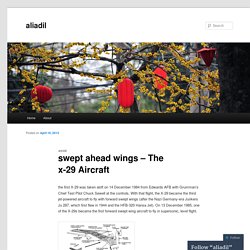

Wing Vortex Devices. Wing Vortex Devices What is the effect of a notch or sawtooth on the leading edge of a wing?

What are the advantages of these devices for high-speed military and commercial aircraft? - question from Mohamed Eldin Leading edge notches and dogtooths, a more common name for a sawtooth, are both types of wing modifications. The two devices are also related to the vortex generator and the leading edge root extension (LERX). Furthermore, a number of other modifications produce similar effects, including the boundary layer fence and the vortilon. Wing aerodynamic devices that create vortices The purpose of these modifications is to create vortices in a controlled and predictable manner. The advantage of wing devices that create vortices is that a vortex adds energy to the airflow and increases its forward momentum.
Common vortex generator design. Air ioniser. This photo shows the sterilisation effects of negative air ionization on a chamber aerosolised with Salmonella enteritidis.

The left sample is untreated; the right, treated. Photo taken in a lab operated by the United States Department of Agriculture. An air ioniser (or negative ion generator or "Chizhevsky's chandelier") is a device that uses high voltage to ionise (electrically charge) air molecules. Negative ions, or anions, are particles with one or more extra electrons, conferring a net negative charge to the particle. Cations are positive ions missing one or more electrons, resulting in a net positive charge. Air ionisers have been used to eliminate the occurrence of air-borne bacterial infections and to reduce static electricity buildup in electronics. Ionic air purifiers[edit] Air ioniser and purifier with its dust collection plates removed Air ionisers are used in air purifiers to remove particles from air.
Ions versus ozone[edit] Adverse health effects[edit] See also[edit] General Dynamics F-16XL. The General Dynamics F-16XL is a derivative of the F-16 Fighting Falcon, with a cranked-arrow delta wing.

It was originally conceived as a technology demonstrator, later entered in the United States Air Force's (USAF) Enhanced Tactical Fighter (ETF) competition but lost to the F-15E Strike Eagle. Several years after the prototypes were shelved, they were turned over to NASA for additional aeronautical research. Development[edit] F-16XL Graphic. High-Speed Research (HSR) - Smoothing the Flow Over Supersonic Wings.
High-Speed Research (HSR) - Smoothing the Flow Over Supersonic Wings FS-1996-09-17-LaRC September 1996 *** NOTE: The NASA HSR Program was phased out in fiscal year 1999. *** Supersonic Laminar Flow Control One goal of NASA's High-Speed Research (HSR) program is to achieve laminar, or smooth, airflow over the surface of an aircraft's wing while flying at supersonic speeds.

The Airfoil Misconception in K-6 Textbooks. Other websites "Newtonian" Lifting Force References Cliff Swartz, "Numbers Count", editorial in THE PHYSICS TEACHER, p536, Vol34, Dec 1996 Gale Craig, NEWTONIAN AERODYNAMICS FUNDAMENTALS, 1995, Regenerative Press, Anderson Indiana 46011, ISBN: 0964680602 Prof.

Untitled. Swept ahead wings – The x-29 Aircraft. The first X-29 was taken aloft on 14 December 1984 from Edwards AFB with Grumman’s Chief Test Pilot Chuck Sewell at the controls.

Ion thruster. NASA's 2.3 kW NSTAR ion thruster for the Deep Space 1 spacecraft during a hot fire test at the Jet Propulsion Laboratory Ion thrusters are categorized by how they accelerate the ions, using either electrostatic or electromagnetic force.

Electrostatic thrusters use the Coulomb force and accelerate the ions in the direction of the electric field. Electromagnetic thrusters use the Lorentz force. In either case, when an ion passes through an electrostatic grid engine, the potential difference of the electric field converts to the ion's kinetic energy. Applications include control of the orientation and position of orbiting satellites (some satellites have dozens of low-power ion thrusters) and use as a main propulsion engine for low-mass robotic space vehicles (for example Deep Space 1 and Dawn).[1][2]
Energy2D - Interactive Heat Transfer Simulations for Everyone. “Please accept our thanks and congratulations for your very interesting work which I am sure are having a great positive impact in our society.” — from Roberto Quevedo, Instituto Volcanológico de Canarias, INVOLCAN, Puerto de la Cruz, Tenerife, Canary Islands, Spain By Carmen Trudell, University of Virginia What is it?

Based on computational physics research ([1], [2], [3]), Energy2D is an interactive, visual multiphysics simulation program that models all three modes of heat transfer—conduction, convection, and radiation, and their coupling with particle dynamics. Energy2D runs very quickly on most computers and eliminates the switches among preprocessors, solvers, and postprocessors typically needed to perform computational fluid dynamics simulations. It allows you to design "computational experiments" to test a scientific hypothesis or solve an engineering problem without resorting to complex mathematics.
Diverterless supersonic inlet. Testing of the F-35 diverterless supersonic inlet on an F-16 testbed.

The original intake is shown in the top image. DSIs can be used to replace the intake ramp and inlet cone, which are more complex, heavy and expensive.[1] Technical Background[edit] The Materials Used in the Design of Aircraft Wings. By Alessio Spampinato Image Credit: Maciej Bledowski | Shutterstock.com The design of an aircraft must take in consideration a multitude of factors such as efficiency, comfort, safety and reliability.
